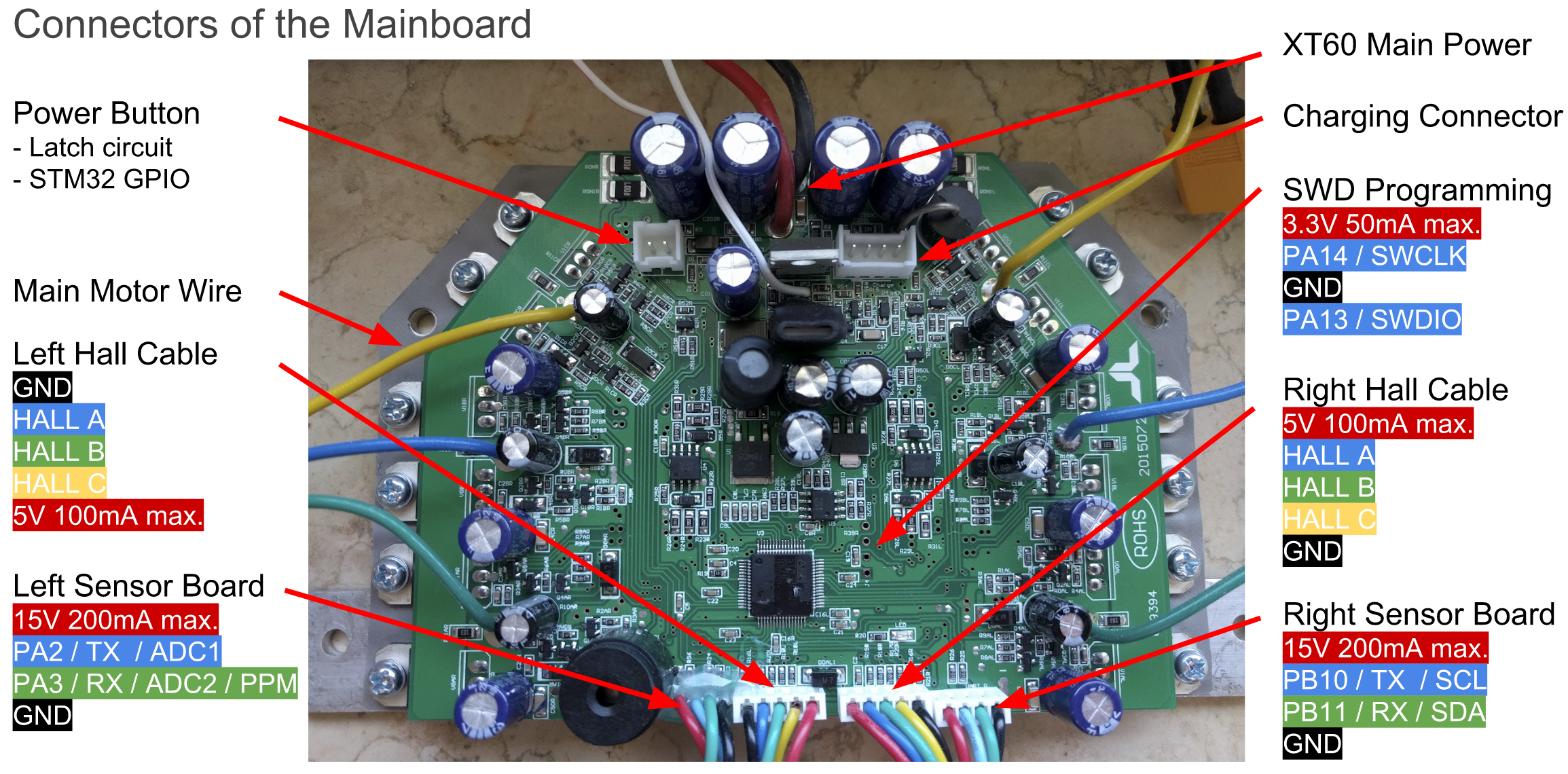bipropellant[ bahy-pruh-pel-uh nt ] - Most liquid-propellant rockets use bipropellant systems — i.e., those in which an oxidizer and a fuel are tanked separately and mixed in the combustion chamber.
This repo, when mixed with the protocol repo, rocket-propels your hoverboard derived projects, now with added sinusoidal motor control.
This firmware is a heavily modified version of Niklas Fauth's hoverboard firmware which allows you to:
- Use the hoverboard AS A HOVERBOARD
- Control externaly the hoverboard with a reliable serial protocol.
This project was started by btsimonh
It branched from Niklas Fauth's hoverboard firmware at this commit: Aug 24, 2018
This allows you to use ANY GPIO pins (with modififcation) as serial. Probably best to stay at 9600 baud, as the receive interrupt is serviced at 8x the bitrate.
It reads the original serial data (9 bit) from the original sensor boards from USART2&3.
Sensor data can control the PWM demands (power to the wheels). Double tap on pads to enable.
Protocol.c implements a simple ASCII serial protocol which allows for manual control of the board.
Protocol.c implements the bones of an acked/checksummed serial protocol. Embryonic as yet, but intended to be a generic control protocol for the hoverboard.
Sample C++ code to send pwm and steer:
setHoverboardPWM(300,-300); // sends 300 (=30% duty cycle forward) to one wheel and -300 (=30% duty cycle backwards) to the other
typedef struct MsgToHoverboard_t{
unsigned char SOM; // Start of Message
unsigned char CI; // continuity counter
unsigned char len; // len is len of bytes to follow, NOT including CS
unsigned char cmd; // read or write
unsigned char code; // code of value to write
int32_t pwm1; // absolute value ranging from -1000 to 1000 .. Duty Cycle *10 for first wheel
int32_t pwm2; // absolute value ranging from -1000 to 1000 .. Duty Cycle *10 for second wheel
unsigned char CS; // checksumm
};
typedef union UART_Packet_t{
MsgToHoverboard_t msgToHover;
byte UART_Packet[sizeof(MsgToHoverboard_t)];
};
char hoverboardCI = 0; // Global variable which tracks CI
void setHoverboardPWM( int32_t pwm1, int32_t pwm2 )
{
UART_Packet_t ups;
ups.msgToHover.SOM = 4 ; // Start of Message, 4 for No ACKs;
ups.msgToHover.CI = ++hoverboardCI; // Message Continuity Indicator. Subsequent Messages with the same CI are discarded, need to be incremented.
ups.msgToHover.len = 1 + 1 + 4 + 4 ; // cmd(1), code(1), pwm1(4) and pwm2(4)
ups.msgToHover.cmd = 'r'; // Pretend to send answer to read request. This way HB will not reply. Change to 'W' to get confirmation from board
ups.msgToHover.code = 0x0E; // "simpler PWM"
ups.msgToHover.pwm1 = pwm1;
ups.msgToHover.pwm2 = pwm2;
ups.msgToHover.CS = 0;
for (int i = 0; i < (2 + ups.msgToHover.len); i++){ // Calculate checksum. 2 more for CI and len.
ups.msgToHover.CS -= ups.UART_Packet[i+1];
}
Serial.write(ups.UART_Packet,sizeof(UART_Packet_t));
}
This code is only able to write values to the board, replies can not be parsed. For more information check the hoverboard protocol wiki and examples. An Arduino compatible C++ module which can communicate in both directions can be found at bipropellant-hoverboard-api.
PID control loops for control of Speed (in mm/sec) and Position (in mm). Currently separate control modes, and parameter need better tuning.
Used to read Position and Speed data.
Implements a flash page available for efficitent storage of parameters (currently unused, but tested).
Should work with original control settings (in config.h), but not tested...
Multiple inputs like Joystick, speed throttle and Gametrak can be easily configured. Check out the wiki
The original Hardware supports two 4-pin cables that originally were connected to the two sensor boards. They break out GND, 12/15V and USART2&3 of the Hoverboard mainboard. Both USART2 & 3 can be used for UART and I2C, PA2&3 can be used as 12bit ADCs.
The reverse-engineered schematics of the mainboard can be found here: http://vocke.tv/lib/exe/fetch.php?media=20150722_hoverboard_sch.pdf
The repository uses a submodule for the serial protocol. Clone with submodules: ´git clone --recurse-submodules´ Or afterwards: ´git submodule update --init --recursive´
First take a look at our wiki and open issues, if you still have any problem/question, feel free to open a new issue!
MWR

